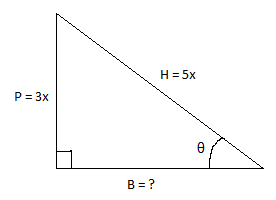Question
Question: Find the value of \(\sin \left( 2{{\sin }^{-1}}\dfrac{3}{5} \right)\) ....
Find the value of sin(2sin−153) .
Solution
In a right-angled triangle with length of the side opposite to angle θ as perpendicular (P), base (B) and hypotenuse (H):
sinθ=HP,cosθ=HB,tanθ=BP
P2+B2=H2 (Pythagoras Theorem)
sin 2θ = 2 sin θ cos θ.
If sin θ = x, then we say sin−1x=θ .
sin(sin−1x)=x .
Complete step-by-step answer:
Let's say that sin−153=θ .
∴ By the definition of inverse trigonometric functions, sinθ=53 .
And, by the definition of trigonometric ratios, sinθ=HP and cosθ=HB .
∴ P = 3x and H = 5x.
It can be represented using a right-angled triangle as follows:

Using the Pythagoras' Theorem:
B=H2−P2=(5x)2−(3x)2=25x2−9x2=16x2=4x .
And thus, cosθ=HB=5x4x=54 .
Now, using the identity sin 2θ = 2 sin θ cos θ, and substituting the values of sinθ=53 and cosθ=54 from above, we will get:
sin(2sin−153)=2(53)(54)
On multiplying the terms on the Right-Hand Side of the equation together, we get:
⇒ sin(2sin−153)=2524 .
Hence, the value of sin(2sin−153) is 2524
Note: The inverse trigonometric functions, sin−1,cos−1,tan−1 ... etc. represent the value of an angle.
The inverse trigonometric functions, sin−1,cos−1,tan−1 ... etc. are also written as arcsin, arccos, arctan ... etc.
If one trigonometric ratio is known, we can use Pythagoras' Theorem and calculate the values of all other trigonometric ratios.
sin−153=36.87∘ .
